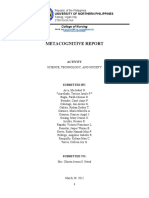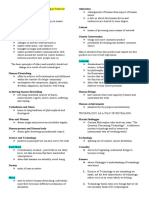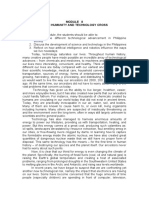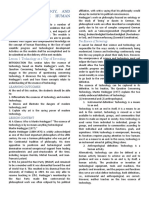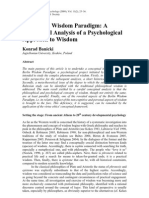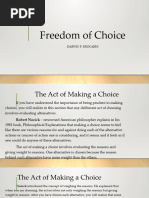1 Technology As A Way of Revealing
1 Technology As A Way of Revealing
Uploaded by
Emmilio DomingoCopyright:
Available Formats
1 Technology As A Way of Revealing
1 Technology As A Way of Revealing
Uploaded by
Emmilio DomingoOriginal Title
Copyright
Available Formats
Share this document
Did you find this document useful?
Is this content inappropriate?
Copyright:
Available Formats
1 Technology As A Way of Revealing
1 Technology As A Way of Revealing
Uploaded by
Emmilio DomingoCopyright:
Available Formats
RIZAL TECHNOLOGICAL UNIVERSITY
RIZA
Cities ofLMandaluyong
TECHNO LO
and GICAL UNIVERSITY
Pasig
Cities of Mandaluyong and Pasig
LESSON 1:
Technology as a Way of
Revealing
Student Name
Section
Schedule
Program
College
Professor
GE07 – Science, Technology, and Society
1ST SEMESTER I 2021 - 2022
0
RIZAL TECHNOLOGICAL UNIVERSITY
Cities of Mandaluyong and Pasig
Technology as a Way of Revealing
Learning Outcomes
At the end of this section, the students should be able to:
1. differentiate the essences of technology and modern technology;
2. discuss and illustrate the dangers of modern technology; and
3. explain why art is the saving power of modern technology.
Topic Presentation
At A Glance: Who is Martin Heidegger?
"The essence of technology is by no means anything technological" — Martin
Heidegger (1977)
Martin Heidegger (1889-1976) is widely acknowledged as one of the most important
philosophers of the 20th century. He was a German philosopher who was part of the
Continental tradition of philosophy. His stern opposition to positivism and technological
world domination received unequivocal support from leading postmodernists and post-
structuralists of the time, including Jacques Derrida, Michel Foucault, and Jean-
Francois Lyotard.
In 1933, he joined the Nazi Party (NSDAP) and remained to be a member until it was
dismantled toward the end of World War II. This resulted in his dismissal from the
University of Freiburg in 1949. He was only able to resume teaching in 1951.
Heidegger's membership to the Nazi Party made him controversial - his philosophical
work was often eclipsed by his political affiliation, with critics saying that his philosophy
would always be rooted in his political consciousness.
Heidegger's work on philosophy focused on ontology or the study of 'being' or dasein
in German. His philosophical works are often described as complicated, partly due to
his use of complex compound German words, such as Seinsvergessenheit
(Forgetfulness of Being), Bodenstondigkeit (Rootedness-in-Soil), and
Wesensverfassung (Essential Constitution).
To know more about the life and philosophy of Heidegger, watch a five-minute
YouTube video entitled, The Philosophy of Martin Heidegger which can be accessed
on this link: https://www.youtube.com/watch?v=Br1sGrA7XTU. Remember, it is
important to understand basic concepts related to Heidegger's philosophy to better
make sense of his work.
GE07 – Science, Technology, and Society 1
RIZAL TECHNOLOGICAL UNIVERSITY
Cities of Mandaluyong and Pasig
The Essence of Technology
It cannot be denied that science and technology are responsible for the ways society
is continuously being modernized. Science and technology continuously seep into the
way people go about their daily lives. However, the omnipresence of science and
technology must not eclipse the basic tenets of ethics and morality. Instead, it should
allow the human person to flourish alongside scientific progress and technological
development. In order to spark the discussion on the role of ethics and social morality
in science and technology, it is necessary to go back to the very essence of technology,
i.e., its definition.
The essence of technology can be captured in its definition. In his treatise, The
Question Concerning Technology, Martin Heidegger (1977) explains the two widely
embraced definitions of technology: instrumental and anthropological
1. Instrumental definition: Technology is a means to an end
Technology is not an end in itself, it is a means to an end. In this context, technology
is viewed as a tool available to individuals, groups, and communities that desire to
make an impact on society. How technology is used varies from individual to individual,
groups to groups, and communities to communities according to their individual and
collective functions, goals, and aspirations. While technology is omnipresent, knowing
its functions requires paying attention to how humans use it as a means to an end. In
this sense, technology is an instrument aimed at getting things done.
2. Anthropological definition: Technology is a human activity.
Alternatively, technology can also be defined as a human activity because to achieve
an end and to produce and use a means to an end is, by itself, a human activity. The
production or invention of technological equipment, tools and machines, the products
and inventions, and the purpose and functions they serve are what define technology.
Both definitions, i.e., instrumental and anthropological, are correct. However, neither
touches on the true essence of technology.
Technology as a Way of Revealing
Heidegger stressed that the true can only be pursued through the correct. Simply, what
is correct leads to what is true. In this sense, Heidegger envisioned technology as a
way of revealing—a mode of 'bringing forth.' Bringing forth can be understood through
the Ancient Greek philosophical concept, poiesis, which refers to the act of bringing
something out of concealment. By bringing something out of concealment, the truth of
that something is revealed. The truth is understood through another Ancient Greek
concept of aletheia, which is translated as unclosedness, unconcealedness,
disclosure, or truth.
Thus, for Heidegger, technology is a form of poems—a way of revealing that
unconceals aletheia or the truth. This is seen in the way the term techne, the Greek
root word of technology, is understood in different contexts. In philosophy, techne
resembles the term episteme that refers to the human ability to make and perform.
Techne also encompasses knowledge and understanding. In art, it refers to tangible
and intangible aspects of life. The Greeks understood techne in the way that it
encompasses not only craft, but other acts of the mind, and poetry.
Technology as Poiesis: Does Modern Technology Bring Forth or Challenge Forth?
GE07 – Science, Technology, and Society 2
RIZAL TECHNOLOGICAL UNIVERSITY
Cities of Mandaluyong and Pasig
Heidegger, in The Question Concerning Technology, posited that both primitive crafts
and modern technology are revealing. However, he explained that modern technology
is revealing not in the sense of bringing forth or poiesis. Heidegger made a clear
distinction between technology and modern technology in that the latter 'challenges'
nature. Modern technology challenges nature by extracting something from it and
transforming, storing, and distributing it.
On the surface, Heidegger's criticism of modern technology might appear
counterintuitive to the purpose of nature to human existence. However, by digging
deeper into Heidegger's question, it becomes clear that the essence of modern
technology is not to bring forth in the sense of poiesis. Instead, Heidegger considers
modern technology's way of revealing as a way of challenging forth. Modern
technology challenges forth, because it makes people think how to do things faster,
more effectively, and with less effort. It prompts people into dominating and enframing
the earth's natural resources. Challenging forth reduces objects as standing-reserve
or something to be disposed of by those who enframe them—humans. This is evident
in the way people exploit natural resources with very little concern for the ecological
consequences that come with it. Challenging forth as a result of modern technology is
also evident in the information age, such that greater control of information to profit
from its value gives rise to concerns about privacy and the protection of human rights.
The challenging forth of modern technology is seen everywhere: in the rise and
depletion of petroleum as a strategic resource; the introduction and use of synthetic
dyes, artificial flavorings, and toxic materials into the consumer stream that bring about
adverse effects on human health; and the use of ripening agents in agriculture that
poses threats to food safety and health security.
Enframing as Modern Technology's Way of Revealing
If the essence of technology can be understood as a way of bringing forth the truth in
the sense of poiesis, Heidegger distinguished the way of revealing of modern
technology by considering it as a process of enframing. Humankind's desire to control
everything, including nature. is captured in this process. By putting things, in this case
nature, in a frame, it becomes much easier for humans to control it according to their
desires.
Enframing, according to Heidegger, is akin to two ways of looking at the world:
calculative thinking and meditative thinking. In calculative thinking, humans desire to
put an order to nature to better understand and control it. In meditative thinking,
humans allow nature to reveal itself to them without the use of force or violence. One
thinking is not necessarily better than the other. In fact, humans are capable of using
both and will benefit from being able to harmonize these ways of looking at the world.
Yet, calculative thinking tends to be more commonly utilized, primarily because
humans' desire to control due to their fear of irregularity.
Enframing, then, is a way of ordering (or framing) nature to better manipulate it.
Enframing happens because of how humans desire for security, even if it puts all of
nature as a standing reserve ready for exploitation. Modern technology challenges
humans to enframe nature. Thus, humans become part of the standing reserve and
an instrument of technology, to be exploited in the ordering of nature. The role humans
take as instruments of technology through enframing is called destining. In destining,
humans are challenged forth by enframing to reveal what is real. However, this
GE07 – Science, Technology, and Society 3
RIZAL TECHNOLOGICAL UNIVERSITY
Cities of Mandaluyong and Pasig
destining of humans to reveal nature carries with it the danger of misconstruction or
misinterpretation.
The Dangers of Technology
The dangers of technology lie in how humans let themselves be consumed by it.
Although humans are looped into the cycle of bringing forth or challenging forth, it is
their responsibility to recognize how they become instruments of technology.
The Brazilian novelist, Paulo Coelho, once remarked that it is boastful for humans to
think that nature needs to be saved, whereas Mother Nature would remain even if
humans cease to exist. Hence, in facing the dangers of technology, the fear of
disappearing from the face of the Earth should concern people more potently than the
fear of the Earth disappearing. As mere tenants on Earth, people must not allow
themselves to be consumed by technology lest they lose the essence of who they are
as human beings. In this sense, humans are in danger of becoming merely part of the
standing reserve or, alternatively, may find themselves in nature.
Recognizing its dangers of technology requires critical and reflective thinking on its
use. For example, social media has indeed connected people in the most efficient and
convenient way imaginable, but it also inadvertently gave rise to issues such as
invasion of privacy, online disinhibition, and proliferation of fake news. The line has to
be drawn between what constitutes a beneficial use of social media and a dangerous
one. As exemplified, social media comes with both benefits and drawbacks.
However, the real threat of technology comes from its essence, not its activities or
products. The correct response to the danger of technology is not simply dismissing
technology altogether. Heidegger (1977) explained that people are delivered over to
technology in the worst possible way when they regard it as something neutral. This
conception of technology, according to Heidegger, to which today humans particularly
like to pay homage, makes them utterly blind to the essence of technology. Ultimately,
the essence of technology is by no means anything technological (Heidegger, 1977).
Art as the Saving Power
Necessary reflection upon and confrontation with technology are required in order to
proactively address the dangers of technology. Friedrich Hölderlin, a German poet
quoted by Heidegger, said: "But where danger is, grows the saving power also" (1977,
p. 14). Following this, the saving power can be traced exactly where the danger is—in
the essence of technology. As mentioned, this essence is not neutral and by no means
anything technological. Along this line, Heidegger proposed art as the saving power
and the way out of enframing: "And art was simply called techne. It was a single,
manifold revealing" (1977, p. 18). Heidegger saw art as an act of the mind, i.e., a
techne, that protected and had great power over the truth. By focusing on art, people
are able to see more clearly how art is embedded in nature. Art encourages humans
to think less from a calculative standpoint where nature is viewed as an ordered
system. Instead, it inspires meditative thinking where nature is seen as an art and that,
in all of art, nature is most poetic. Heidegger encapsulated this as follows:
Because the essence of technology is nothing technological, essential
reflection upon technology and decisive confrontation with it must happen in a
realm that is, on the one hand, akin to the essence of technology and, on the
other, fundamentally different from it. Such a realm is art. But certainly only if
GE07 – Science, Technology, and Society 4
RIZAL TECHNOLOGICAL UNIVERSITY
Cities of Mandaluyong and Pasig
reflection on art, for its part, does not shut its eyes to the constellation of truth
after which we are questioning (1977, p. 19).
Questioning as the Piety of Thought
Heidegger concluded his treatise on technology by saying:
The closer we come to the danger, the more brightly do the ways into the saving
power begin to shine and the more questioning we become. For questioning is
the piety of thought (1977, p. 19).
Heidegger underscored the importance of questioning in the midst of technology. For
him, there is unparalleled wisdom gained only when humans are able to pause, think,
and question what is around them. Humans are consumed by technology when they
are caught up in enframing and fail to pay attention to the intricacies of technology, the
brilliance of the purpose of humankind, and the genius of humans to bring forth the
truth.
Questioning is the piety of thought. It is only through questioning that humans are able
to reassess their position not only in the midst of technology around them, but also,
and most importantly, in the grand scheme of things. Heidegger posited that it is
through questioning that humans bear witness to the crises that a complete
preoccupation with technology brings, preventing them from experiencing the essence
of technology.
Thus, humans need to take a step back and reassess who they were, who they are,
and who they are becoming in the midst of technology in this day and age.
References
• Quinto, EJM & Nieva, AD. 2019. Science, Technology and Society –
Outcome-Based Module. C & E Publishing, Inc. pp62-pp80.
GE07 – Science, Technology, and Society 5
You might also like
- Science, Technology and SocietyDocument23 pagesScience, Technology and SocietyKaiRae Asakura100% (1)
- Social ValuesDocument6 pagesSocial Valuessimply_coool100% (4)
- Gec107 Ethics Notes File 1Document12 pagesGec107 Ethics Notes File 1Larame GallardeNo ratings yet
- Module 2 - STSDocument12 pagesModule 2 - STSLyslyn TesoroNo ratings yet
- Human Flourishing in Science and TechnologyDocument6 pagesHuman Flourishing in Science and TechnologyRaulyns Pearl Dusaban BahianNo ratings yet
- Module 5: Technology As A Way of Revealing: at A Glance: Who Is Martin Heidegger?Document5 pagesModule 5: Technology As A Way of Revealing: at A Glance: Who Is Martin Heidegger?Rena Jocelle NalzaroNo ratings yet
- Technology As A Way of RevealingDocument21 pagesTechnology As A Way of Revealingrose belle garcia50% (4)
- Human Flourishing Written ReportDocument14 pagesHuman Flourishing Written ReportMicole Kate Ortiz100% (2)
- Metacognitive Report: College of NursingDocument8 pagesMetacognitive Report: College of NursingFarah Jelimae BagniNo ratings yet
- Gsts Midterm Group Assignment: Against ScientismDocument2 pagesGsts Midterm Group Assignment: Against ScientismAngelica Joyce SinnacoNo ratings yet
- STS - Technology As A Way of RevealingDocument16 pagesSTS - Technology As A Way of RevealingOdin ParasNo ratings yet
- The Human Person Flourishing in Terms of Science and TechnologyDocument7 pagesThe Human Person Flourishing in Terms of Science and TechnologyDEEJASON MIRANDA DE SILVANo ratings yet
- L-5 Technology As A Way of Revealing MIDTERMDocument29 pagesL-5 Technology As A Way of Revealing MIDTERMJane Harris PalbanNo ratings yet
- Chapter 1 Introduction To Environmental ScienceDocument8 pagesChapter 1 Introduction To Environmental ScienceLoraine Summer CruzNo ratings yet
- 1 - The Medawar Lecture 1998 - Is Science Dangerous - Lewis WolpertDocument7 pages1 - The Medawar Lecture 1998 - Is Science Dangerous - Lewis WolpertJamie ToriagaNo ratings yet
- STS Module Week 7 8 ST and The Human FlourishingDocument8 pagesSTS Module Week 7 8 ST and The Human FlourishingVinz Khyl G. CastillonNo ratings yet
- HUMAN FLOURISHING Converted CompressedDocument42 pagesHUMAN FLOURISHING Converted CompressedJM VillaluzNo ratings yet
- General Concepts of Science, Technology and SocietyDocument8 pagesGeneral Concepts of Science, Technology and SocietyVince Bryan San PabloNo ratings yet
- Climate Change and Environmental AwarenessDocument14 pagesClimate Change and Environmental AwarenessSimon Santos100% (1)
- STS ModuleDocument14 pagesSTS ModuleJuliah Murillo Quiñonez100% (1)
- Ge7 - Science-Technology-SocietyDocument12 pagesGe7 - Science-Technology-SocietyJohn Paul Dela CruzNo ratings yet
- STS ReviewerDocument6 pagesSTS ReviewerPrincess Lheakyrie CasilaoNo ratings yet
- Week 11 - STS Information AgeDocument6 pagesWeek 11 - STS Information AgeGilda Genive AriolaNo ratings yet
- Mst112 Final Reviewer Part 1Document5 pagesMst112 Final Reviewer Part 1John MichaelNo ratings yet
- MCKEVIN ENRIQUEZ Learning Activity 3 - Intellectual Revolution That Defined SocietyDocument2 pagesMCKEVIN ENRIQUEZ Learning Activity 3 - Intellectual Revolution That Defined SocietySydney Edelweiss MadridNo ratings yet
- STS Notes MidtermsDocument12 pagesSTS Notes MidtermsHey Its Me100% (1)
- STS - Information AgeDocument2 pagesSTS - Information AgeNathan TanNo ratings yet
- Sts MidtermDocument3 pagesSts MidtermGomez Agustin LeslieNo ratings yet
- Module 8 When Humanity and Technology CrossDocument9 pagesModule 8 When Humanity and Technology CrossMeliodas AsasasNo ratings yet
- Technology As A Way of RevealingDocument41 pagesTechnology As A Way of RevealingJaneth Miguel SatrainNo ratings yet
- 2 GE Course Outline - Science, Technology & SocietyDocument6 pages2 GE Course Outline - Science, Technology & Societypeterpaul_1211No ratings yet
- Human Flourishing Group 2Document22 pagesHuman Flourishing Group 2Dickston AlojadoNo ratings yet
- Study Guide 2 StsDocument6 pagesStudy Guide 2 StsAngelo EdralinNo ratings yet
- CHAPTER 3 Intellectual Revolution That Define SocietyDocument27 pagesCHAPTER 3 Intellectual Revolution That Define SocietyYna Mae Sto DomingoNo ratings yet
- Lapuz, Aegiaille M. Sts 1 Midterm ExamDocument5 pagesLapuz, Aegiaille M. Sts 1 Midterm ExamJeyl LapuzNo ratings yet
- Climate ChangeDocument28 pagesClimate ChangeRose Belle A. GarciaNo ratings yet
- GEd 109 Science, Technology and SocietyDocument86 pagesGEd 109 Science, Technology and SocietyDome Palma GuerraNo ratings yet
- The Human Person Flourishing N Terms of Science and TechnologyDocument22 pagesThe Human Person Flourishing N Terms of Science and TechnologyDickston Alojado0% (1)
- LECTURE2 Historical Antecedents of Science and TechnologyDocument5 pagesLECTURE2 Historical Antecedents of Science and TechnologyFiel Ericson SolaresNo ratings yet
- Human Flourishing in Terms of S&TDocument15 pagesHuman Flourishing in Terms of S&TJohn Zedrick MacaisaNo ratings yet
- 3 Imperial SpainDocument56 pages3 Imperial Spainbatutascribd50% (2)
- MMWDocument60 pagesMMWAngel Roann PresildaNo ratings yet
- 12 When Technology and Humanity CrossDocument15 pages12 When Technology and Humanity CrossKaye VelascoNo ratings yet
- Major Development Programs and Personalities in The PhilippinesDocument9 pagesMajor Development Programs and Personalities in The Philippinesjoan7casillano7tegerNo ratings yet
- Science Technology and Society: Ebonia B. Seraspe UP VisayasDocument51 pagesScience Technology and Society: Ebonia B. Seraspe UP Visayaspeachnick100% (2)
- Science, Technology and SocietyDocument22 pagesScience, Technology and SocietyKevin Jones CalumpangNo ratings yet
- Social Science-General EducationDocument8 pagesSocial Science-General EducationDENNIS AFABLENo ratings yet
- Lesson 2: Human Flourishing Reflected in Progress and DevelopmentDocument6 pagesLesson 2: Human Flourishing Reflected in Progress and DevelopmentJohn OpeñaNo ratings yet
- Subject Verb Agreement: Falculan Twins' Review CenterDocument1 pageSubject Verb Agreement: Falculan Twins' Review CenterRicar CaneteNo ratings yet
- Science Technology and Society: International School of Technology, Arts and Culinary of Davao City INCDocument83 pagesScience Technology and Society: International School of Technology, Arts and Culinary of Davao City INCLore StefanNo ratings yet
- History of Manila ScienceDocument2 pagesHistory of Manila ScienceRephotsirhc AicruNo ratings yet
- The Question Concerning TechnologyDocument44 pagesThe Question Concerning TechnologyDavid PerryNo ratings yet
- Mathematics in Our WorldDocument23 pagesMathematics in Our WorldRose ChuNo ratings yet
- STS FinalsDocument4 pagesSTS FinalsCrestina100% (1)
- Science, Technology and SocietyDocument21 pagesScience, Technology and SocietySarah YumulNo ratings yet
- Lesson 1 Introduction To EthicsDocument2 pagesLesson 1 Introduction To EthicsXio Wen100% (2)
- PresentationDocument30 pagesPresentationMaruja familara100% (3)
- Lesson 2 Communication and GlobalizationDocument13 pagesLesson 2 Communication and Globalizationmaryjane percibalNo ratings yet
- Republic of The Philippines: Biliran Province State University ISO 9001:2015 CERTIFIEDDocument43 pagesRepublic of The Philippines: Biliran Province State University ISO 9001:2015 CERTIFIEDBrett AmbilNo ratings yet
- STS MidtermDocument5 pagesSTS MidtermKarl NagasaoNo ratings yet
- Module 4 STSDocument18 pagesModule 4 STSJohn Michael LaurioNo ratings yet
- Ilm # 4 Chapter 4Document7 pagesIlm # 4 Chapter 4Marielle Eser JoseNo ratings yet
- Work Values of Secondary Grade Teachers Based On Certain Selected VariablesDocument11 pagesWork Values of Secondary Grade Teachers Based On Certain Selected VariablesprusothmahaNo ratings yet
- Good Manners and Right Conduct: Instructor: Ms. Leah O. ViajanteDocument12 pagesGood Manners and Right Conduct: Instructor: Ms. Leah O. ViajanteJulhayda FernandoNo ratings yet
- The Case For Biotic Rights - NashDocument15 pagesThe Case For Biotic Rights - NashMichelle Ann OrendainNo ratings yet
- 4 F 9 e 5 D 62 F 05 Dafab 2 e 31Document70 pages4 F 9 e 5 D 62 F 05 Dafab 2 e 31zeidNo ratings yet
- UHV - An IntroductionDocument6 pagesUHV - An IntroductionRakesh BarikNo ratings yet
- Hv&e - Unit - IDocument22 pagesHv&e - Unit - IPratham KangraNo ratings yet
- The Berlin Wisdom ParadigmDocument12 pagesThe Berlin Wisdom ParadigmSergey KhonskiyNo ratings yet
- Velasquez Business Ethics - Short VersionDocument69 pagesVelasquez Business Ethics - Short VersionIndraNo ratings yet
- Freedom of ChoiceDocument8 pagesFreedom of Choiceeurybondoc90No ratings yet
- HVPE Unit 1 NotesDocument22 pagesHVPE Unit 1 NotesVAISHNAVI RAJENDRA ARORANo ratings yet
- Activity 4 PDFDocument1 pageActivity 4 PDFHaron NoorNo ratings yet
- 1 Technology As A Way of RevealingDocument6 pages1 Technology As A Way of RevealingEmmilio DomingoNo ratings yet
- Political ObligationDocument12 pagesPolitical Obligationyashanand235No ratings yet
- Cumminsky 90Document1 pageCumminsky 90GraduatedNo ratings yet
- Sandra Shapshay - Reconstructing Schopenhauer's Ethics - Hope, Compassion, and Animal Welfare-Oxford University Press (2019)Document249 pagesSandra Shapshay - Reconstructing Schopenhauer's Ethics - Hope, Compassion, and Animal Welfare-Oxford University Press (2019)Jason Burrage100% (2)
- Ethics Mid Term Exam ReviewerDocument3 pagesEthics Mid Term Exam ReviewerRuben LipanaNo ratings yet
- A Eudaimonic Theory of Marital Quality: Laine Owers and Eghan WenzDocument19 pagesA Eudaimonic Theory of Marital Quality: Laine Owers and Eghan Wenzanon_160041092No ratings yet
- Pancasila Education As The Ethical SystemDocument14 pagesPancasila Education As The Ethical SystemFikri EffendiNo ratings yet
- Respect Learning MaterialsDocument51 pagesRespect Learning MaterialsTbone SteakNo ratings yet
- Lecure 1 Value and Value ClarificationDocument9 pagesLecure 1 Value and Value Clarificationangelicdevil906No ratings yet
- Midterm Lesson 4 Human Person and The EnvironmentDocument24 pagesMidterm Lesson 4 Human Person and The EnvironmentJacqueline FloresNo ratings yet
- Consequentialism (Utilitarianism)Document15 pagesConsequentialism (Utilitarianism)Shem Aldrich R. BalladaresNo ratings yet
- Environmental Worldviews, Ethics and SustainabilityDocument10 pagesEnvironmental Worldviews, Ethics and SustainabilityesilvardsNo ratings yet
- GMRC in A Global ContextDocument8 pagesGMRC in A Global Contextjunnie goloranNo ratings yet
- Fenomenologia Del Placer Prodok80Document15 pagesFenomenologia Del Placer Prodok80César Rosada LomeroNo ratings yet
- Should BATMAN Kill The JOKER?Document21 pagesShould BATMAN Kill The JOKER?Genrev GorgNo ratings yet
- What Is The Value of A Human BeingDocument4 pagesWhat Is The Value of A Human Beingapi-3702167No ratings yet
- The Theory of Accountability by Sam SilversteinDocument207 pagesThe Theory of Accountability by Sam SilversteinMadai PeNo ratings yet








